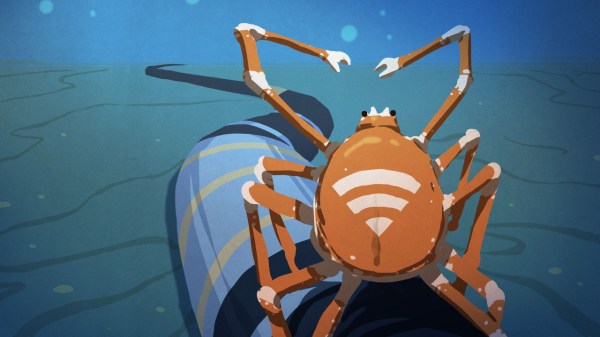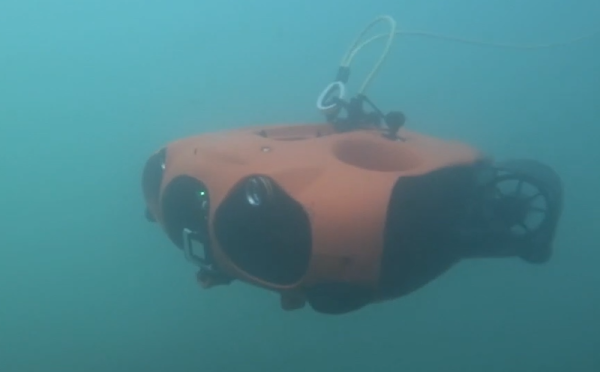Disappointing news this week for those longing for same-hour Amazon delivery as the retail giant tapped the brakes on its Prime Air drone deliveries. The pause is partially blamed on a December incident at the company’s Pendleton, Oregon test facility, where two MK30 delivery drones collided in midair during light rain conditions. A Bloomberg report states that the crash, which resulted in one of the drones catching fire on the ground, was due to a software error related to the weather. As a result, they decided to ground their entire fleet, which provides 60-minute delivery to test markets in Arizona and Texas, until a software update can be issued.
undersea7 Articles
Under The Sea: Optical Repeaters For Submarine Cables
Once a month or so, I have the privilege of sitting down with Editor-in-Chief Elliot Williams to record the Hackaday Podcast. It’s a lot of fun spending a couple of hours geeking out together, and we invariably go off on ridiculous tangents with no chance of making the final cut, except perhaps as fodder for the intro and outro. It’s a lot of work, especially for Elliot, who has to edit the raw recordings, but it’s also a lot of fun.
Of course, we do the whole thing virtually, and we have a little ritual that we do at the start: the clapping. We take turns clapping our hands into our microphones three times, with the person on the other end of the line doing a clap of his own synchronized with the final clap. That gives Elliot an idea of how much lag there is on the line, which allows him to synchronize the two recordings. With him being in Germany and me in Idaho, the lag is pretty noticeable, at least a second or two.
Every time we perform this ritual, I can’t help but wonder about all the gear that makes it possible, including the fiber optic cables running beneath the Atlantic Ocean. Undersea communications cable stitch the world together, carrying more than 99% of transcontinental internet traffic. They’re full of fascinating engineering, but for my money, the inline optical repeaters that boost the signals along the way are the most interesting bits, even though — or perhaps especially because — they’re hidden away at the bottom of the sea.
Continue reading “Under The Sea: Optical Repeaters For Submarine Cables”
Keeping The Noise Down Under The Sea
Since sound is the primary sense used by most ocean life, disruptions to the natural noise levels in the ocean from human activities can be particularly problematic for marine life. [DW Planet A] has a video describing some of the ways we can mitigate these disruptions to our friends under the sea.
Being noisy neighbors isn’t just a problem for whales but for everything down to the plankton at the base of the food web. Underwater construction like offshore wind installations get flak for being noisy, but technologies like bubble curtains can reduce noise output by up to 90% to the surrounding waters while still getting those nice low carbon energy benefits that prevent further ocean acidification and warming. Continue reading “Keeping The Noise Down Under The Sea”
Underwater Drone Films, Is In Film
Having a drone that can follow you running or biking with a camera isn’t big news these days. But French firm Notilo Plus has an underwater drone that can follow and video an underwater diver. The Seasam has been around since 2019, but recently made an appearance in a French film, The Deep House about a couple exploring an underwater haunted house, as reported by New Atlas. You can see a video about the drone — and a trailer for the movie — in the videos below.
To follow a diver, the robot uses an acoustic signal from the user’s control unit to find the approximate location of the user. This works even in dark conditions. Once close enough, computer vision zeros in on the diver while a sonar system allows safe navigation.
DARPA Enlisting Nemo And Dory To Find You
The ocean is a hostile environment for man-made equipment, no matter its purpose. Whether commercial fishing, scientific research, or military operations, salt water is constantly working to break them all down. The ocean is also home to organisms well-adapted to their environment so DARPA is curious if we can leverage their innate ability to survive. The Persistent Aquatic Living Sensors (yes, our ocean PALS) program is asking for creative ideas on how to use sea life to monitor ocean activity.
Its basic idea is simple: everyday business of life in the ocean are occasionally interrupted by a ship, a submarine, or some other human activity. If this interruption can be inferred from sea life response, getting that data could be much less expensive than building sensors to monitor such activity directly. Everyone who applies to this research program will have the chance to present their own ideas on how to turn this idea into reality.
The program announced it will “study natural and modified organisms” (emphasis ours.) Keeping an open mind to bio-engineering ideas will be interesting, but adding biohacking to the equation also adds to the list of potential problems. While PALS will keep its research within contained facilities, any future military deployment obviously will not. Successful developments in this area will certainly raise eyebrows and face resistance against moving beyond the lab.
But such possibilities are still far away in a future that many never arrive, as is common with DARPA initiatives. Very recently we talked about their interest in brain stimulation and we’ve been fascinated by many DARPA initiatives before that. If PALS takes off, their living sensor nodes might end up face to face with the open-source underwater glider project that won this year’s Hackaday prize.
[via Engadget]
Electronics That Can Handle The Pressure
Deep-sea exploration is considered as a relatively new area of research and the electronics involved has to be special in order to survive some of the deepest parts of the ocean. Pressure Tolerant Electronics is a new subject and has its own challenges as explained by [Nic Bingham] of the Schmidt Ocean Institute.
[Nic Bingham] was one of the speakers at the Supplyframe office for ‘The Hardware Developers Didactic Galactic’ held April 20th 2017. His talks was based on his experience with ambient-pressure electronics and autonomous solar-diesel power plants at the Antarctic plateau. Due to high pressures at large depths, the selection of components becomes critical. Low density components such as electrolytic capacitors have either air or fluids which are susceptible to compression under water and prone to damage. Since pressure tolerance is not part of most datasheet figures, component selection becomes difficult and subject to prior testing.
There are other challenges as well as [Nic Bingham] explains that revolve around the procurement of special parts as well as spare for older components. In his whitepaper, [Nic Bingham] chalks out everything from the development process to different testing methodologies and even component selection for such applications.
A video of his talk is worth a watch along with the nice writeup by [Chris Gammell] on his first hand experience of the lecture. For those who are looking for something on a budget, the underwater glider project is a good start. Continue reading “Electronics That Can Handle The Pressure”
What Lies Beneath: The First Transatlantic Communications Cables
For some reason, communications and power infrastructure fascinates me, especially the long-haul lines that move power and data over huge distances. There’s something about the scale of these projects that really gets to me, whether it’s a high-tension line marching across the countryside or a cell tower on some remote mountain peak. I recently wrote about infrastructure with a field guide that outlines some of the equipment you can spot on utility poles. But the poles and wires all have to end at the shore. Naturally we have to wonder about the history of the utilities you can’t see – the ones that run under the sea.
Continue reading “What Lies Beneath: The First Transatlantic Communications Cables”


















